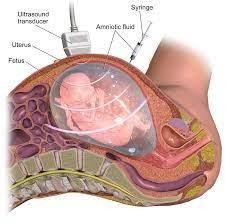A nurse is reinforcing teaching with a client who is at 15 weeks of gestation and is about to undergo an amniocentesis. The nurse should reinforce that this test can identify which of the following traits or problems? (Select all that apply.)
Cephalopelvic disproportion
Neural tube defects
Rh incompatibility
Fetal gender
Chromosome defects
Correct Answer : B,C,D,E
Choice A rationale: Cephalopelvic disproportion is a condition where the baby's head is too large or the mother's pelvis is too small for a vaginal delivery. Amniocentesis does not provide information about this condition.
Choice B rationale: Amniocentesis can be used to detect neural tube defects such as spina bifida and anencephaly.
Choice C rationale: Rh incompatibility occurs when the mother is Rh-negative, and the fetus is Rh-positive. This can lead to hemolytic disease of the newborn (HDN) if untreated. While Rh incompatibility can be detected through blood tests (maternal blood), amniocentesis is typically not used to diagnose this condition.
Choice D rationale: Amniocentesis can be used to determine the fetal gender by analyzing the DNA in the amniotic fluid. This is not the primary purpose of amniocentesis, but it can certainly identify the gender, especially in cases where this information is needed for medical reasons, such as gender-linked genetic disorders.
Choice E rationale: Amniocentesis is commonly used to screen for chromosomal abnormalities such as Down syndrome (trisomy 21) and other genetic conditions.

Nursing Test Bank
Naxlex Comprehensive Predictor Exams
Related Questions
Correct Answer is C
Explanation
Choice A rationale: The presence of phosphatidylglycerol (PG) in the amniotic fluid is another indicator of fetal lung maturity. The absence of PG is associated with an increased risk of respiratory distress syndrome (RDS) in the newborn.
Choice B rationale: A nonstress test is a test performed during pregnancy to evaluate the fetal heart rate in response to fetal movement. It is not directly related to assessing fetal lung maturity.
Choice C rationale: The L/S ratio is an important indicator of fetal lung maturity. Lecithin and sphingomyelin are two surfactants present in the lungs, and the ratio of these two substances increases as the fetal lungs mature. An L/S ratio of 2:1 or greater is considered an indication of lung maturity and suggests that the newborn should be able to breathe adequately after birth.
Choice D rationale: The biophysical profile (BPP) is a prenatal ultrasound assessment of the fetus, which includes evaluating fetal movements, breathing, heart rate, and amniotic fluid volume. While a BPP of 8 is a reassuring score, it does not provide direct information about fetal lung maturity.
Correct Answer is B
Explanation
Choice A rationale:
Placing only part of the nipple in the baby's mouth may result in an ineffective latch, leading to breastfeeding difficulties.
Choice B rationale:
Placing the nipple and 2 to 3 cm of areolar tissue around the nipple into the baby’s mouth aids in adequately compressing the milk ducts. This placement decreases stress on the nipple and prevents cracking and soreness.
Choice C rationale:
Placing the entire areolar is not appropriate.
Choice D rationale:
While babies do have natural instincts to breastfeed, it is essential to provide the mother with specific guidance on achieving a proper latch to ensure successful breastfeeding.
Whether you are a student looking to ace your exams or a practicing nurse seeking to enhance your expertise , our nursing education contents will empower you with the confidence and competence to make a difference in the lives of patients and become a respected leader in the healthcare field.
Visit Naxlex, invest in your future and unlock endless possibilities with our unparalleled nursing education contents today
Report Wrong Answer on the Current Question
Do you disagree with the answer? If yes, what is your expected answer? Explain.
Kindly be descriptive with the issue you are facing.
